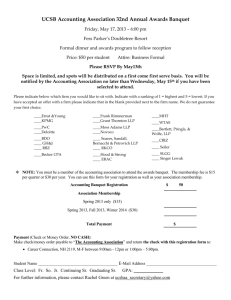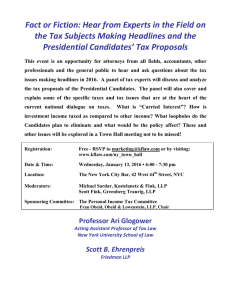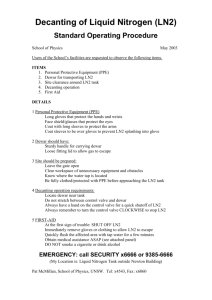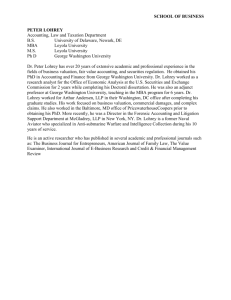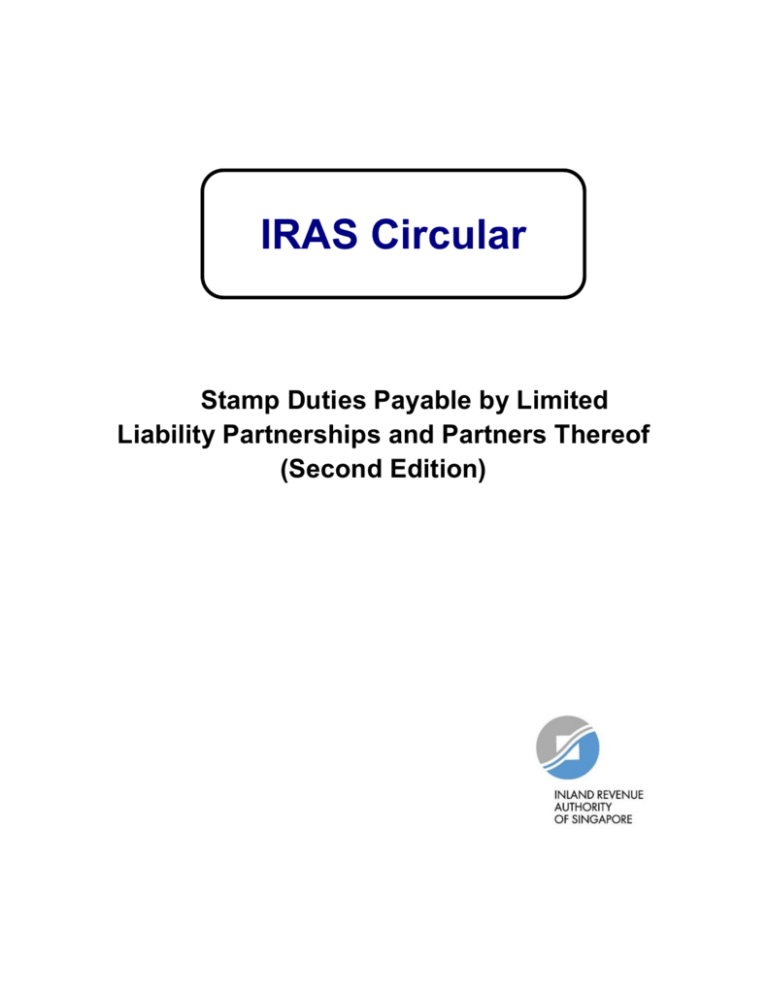
IRAS Circular
Stamp Duties Payable by Limited
Liability Partnerships and Partners Thereof
(Second Edition)
Published by
Inland Revenue Authority of Singapore
First published on 26 April 2005
Second Edition published on 18 March 2011
Second Edition changes
Paragraphs
6 – Amend paragraph 6 to provide that nominal stamp duty is removed for instruments that
are executed on or after 19 February 2011
7- Rephrase the heading to include “a company”
8- To replace paragraph 8 with new information on additional condition imposed in the relief
for conversion of a firm to an LLP
9-To replace paragraph 9 with new information on the new relief extended to conversion of
an existing company to an LLP
Frequently Asked Questions
Questions 6 and 7 are removed.
© Inland Revenue Authority of Singapore
All rights reserved. No part of this publication may be
reproduced or transmitted in any form or by any means,
including photocopying and recording without the written
permission of the copyright holder, application for which
should be addressed to the publisher. Such written
permission must also be obtained before any part of this
publication is stored in a retrieval system of any nature.
1
IRAS CIRCULAR
STAMP DUTIES PAYABLE BY LIMITED LIABILITY PARTNERSHIPS AND
PARTNERS THEREOF
INTRODUCTION
Pursuant to the introduction of limited liability partnerships by the Limited
Liability Partnerships Act 2005, the Stamp Duties Act was amended to provide for
special rules in relation to limited liability partnerships (“LLPs”) and partners thereof.
This circular outlines those amendments.
LIMITED LIABILITY PARTNERSHIPS
2
An LLP is a legal person. Accordingly, it would be liable to pay stamp duties
on any dutiable instrument as provided under the Stamp Duties Act.
3
Hence, if, for example, an LLP acquires immovable property on its formation,
it would have to pay stamp duty on the conveyance of that immovable property.
Conversion of a company or firm to an LLP
4
However, under the Limited Liability Partnerships Act 2005, where a company
or firm converts to an LLP, all the assets of that company or firm would vest in the
LLP automatically. In other words, there may not be any written instrument effecting
the transfer of those assets.
5
Nonetheless, stamp duty would be payable on the transfer of assets from the
company or firm to the LLP. For this purpose, the notice of registration issued by the
Registrar of Limited Liability Partnerships shall be deemed to be a conveyance on
sale of the assets of the company or firm to the LLP. Ad valorem stamp duty would
be payable on the value of the chargeable assets (assets chargeable to stamp duties,
i.e. immovable property, stocks or shares, or any interest thereof).
6
The notice of registration is required to be stamped within 14 days from the
date of registration. Any other instrument relating to the same transfer of the
chargeable assets that may be executed prior to 19 February 2011 is also required
to be stamped but would be chargeable with stamp duty of $10. Any other instrument
relating to the same transfer of the chargeable assets that may be executed on or
after 19 February 2011 is not required to be stamped.
Relief for conversion of a company or firm to an LLP
7
To facilitate the conversion of existing firms to LLPs, relief from the above
stamp duty is allowed to a firm converting to an LLP if the following conditions are
met:
a. The partners of the LLP are those of the firm as at the date of conversion
2
b. The assets of the LLP are those of the firm as at the date of conversion
c. The capital contributed by each of the partner of the LLP remain the same
as in the original firm as at the date of conversion
8.
As announced in Budget 2011, an additional condition is introduced to the
relief for conversion of firm to an LLP. At least 75% of the composition of the
partnership interest in the LLP held by the partners immediately after the conversion
should remain the same for 2 years after the conversion. Greater details can be
found in the e-tax Guide: “Stamp Duty: Relief for the Transfer of Assets upon
Conversion of a firm to a Limited Liability Partnership (LLP)”. The e-tax Guide can be
found at www.iras.gov.sg > Quick Links > e-Tax Guides > Stamp Duty
9
In addition, the Government has also announced in Budget 2011 that stamp
duty relief would be extended to the transfer of assets from a company to the LLP
upon conversion of an existing company to an LLP. This relief applies to a company
that is converted to an LLP on or after 19 Feb 2011. More details can be found in the
e-tax Guide: “Stamp Duty: Relief for the Transfer of Assets upon Conversion of an
existing Company to a Limited Liability Partnership (LLP)”. The e-tax Guide can be
found at www.iras.gov.sg > Quick Links > e-Tax Guides > Stamp Duty
PARTNERS OF AN LLP
10
Although an LLP would have paid stamp duty on chargeable assets acquired
by it, it is possible thereafter for the chargeable assets to be transferred indirectly by
the partners of the LLP transferring their interests in the LLP, instead of the assets
themselves, to a buyer. Stamp duty would be avoided if the transfer of an interest in
an LLP is not also chargeable with stamp duty.
11
On the other hand, it is recognised that it would be onerous for partners to
have to pay stamp duty every time there is any adjustment to the interests of the
partners in an LLP.
12
Consequently, stamp duty is only chargeable on transfers of interests in an
LLP upon a significant change of partners.
Significant change of partners
13
There is only a change of partners if one or more person joins or leaves the
LLP as a partner.
14
A change of partners is significant if, when compared against any specified
date(s):
a. 50% or more of the partners on any specified date(s) have left;
3
b. 50% or more of the partners are new; or
c. the partners have transferred their interests in the LLP such that any of the
partners have, in the aggregate, increased their share of the assets of the LLP
by 50% or more.
15
The specified date(s) for the above comparison is:
a. the date of any change of partners up to and including the date of the last
significant change of partners in the past 2 years;
b. or if there was no significant change of partners in the past 2 years –
i)
ii)
the date of any change of partners within the past 2 years; and
the date 2 years ago or the date of the formation of the LLP, whichever
is the later in time.
16
The specified date that, when compared against a change of partners, results
in the change of partners being a significant change of partners shall be referred to
as the “triggering specified date” in this circular. If there is more than one such date,
only the latest in time shall be the triggering specified date.
Stamp duty chargeable upon significant change of partners
17
Upon a significant change of partners, every partner who has increased his
share of the assets of the LLP from the triggering specified date (including any new
partner) is liable to pay stamp duty.
18
The amount of duty payable is, however, computed from the increase in the
partner’s share of the assets of the LLP from the last significant change of partners
(or if none, from the formation of the LLP). The formula is:
[Current asset share – Asset share at last significant change of
partners (nil for new partner)] X Value of chargeable assets =
Value on which ad valorem duty is charged
19
Every partner who is liable to pay stamp duty is required under the Stamp
Duties Act to notify the Commissioner of Stamp Duties by completing and submitting
the Notification Form (Annex A) within 14 days of the significant change of partners.
The Notification Form may be downloaded from the IRAS website.
20
As stamp duty is charged on a written instrument, in the absence of such an
instrument, the submitted Notification Form is deemed to be such an instrument and
is stamped accordingly. The stamped Notification Form should be retained by the
partner as evidence of the stamp duty paid.
21
Illustrative examples of what constitutes a significant change of partners and
how much duty may be payable are contained in Annex B.
4
TRANSFERS BETWEEN AN LLP AND PARTNERS THEREOF
22
Under the above rules, a partner may pay stamp duty in respect of his share
of the chargeable assets of the LLP. It would therefore be equitable, in the case
where stamp duty is payable on any transfer of chargeable asset between an LLP
and a partner, to give credit for the partner’s share in those chargeable assets. This
would also apply in the case where a new partner makes a contribution-in-kind of
chargeable assets to the LLP when he is admitted to the LLP.
23
The stamp duty payable in such a transaction would be reduced by a
proportion equal to the partner’s share of the assets of the LLP immediately after the
last significant change of partners (if he was not a partner then, this would be nil), or,
if there was no previous significant change of partners, at the formation of the LLP.
In the case of a new partner, who makes a contribution-in-kind of chargeable assets
to the LLP, the proportion of stamp duty reduced is his share of the assets of the LLP
on the date of his admission as a partner.
24
An application for the stamp duty reduction must be submitted to the
Commissioner of Stamp Duties within 14 days from the date of execution of the
Agreement for the disposal of the property or, in the absence of an Agreement,
within 14 days from the date of execution of the Conveyance. The following
information must be furnished with the application:
a. A copy of the document executed for the disposal of the chargeable asset
b. The asset share of the partner at the last significant change of partners or at
formation of the LLP (furnish documents to support asset share), or the asset
share of a new partner as on the date of his admission to the LLP
c. The value of the chargeable asset transferred (furnish valuation report for real
property / audited statement of accounts for shares)
d. The amount of consideration paid for the transfer
25
Notwithstanding any reduction of stamp duty, a minimum duty of $10 would
be charged.
FREQUENTLY ASKED QUESTIONS
26
A list of frequently asked questions is contained in Annex C.
ENQUIRIES
27
Enquiries may be made to Stamp Duties Branch onTel No: 63513697 and
63513698.
Inland Revenue Authority of Singapore
5
Annex A
This notification must be submitted to the Commissioner of Stamp Duties
within 14 days after the effective date of a significant change of partners.
6
Annex B
ILLUSTRATIVE EXAMPLES OF SIGNIFICANT CHANGE OF PARTNERS
AND AMOUNT OF DUTY PAYABLE
Example 1
The LLP has three partners A, B and C on 1 January 2005. Two new partners, D and
E, join on 1 January 2006. This is not a significant change of partners.
On 1 January 2007, E sells his interest in the LLP to F and G. There is a significant
change of partners compared to 1 January 2005 since half of the partners are new
(D, F and G). Ad valorem duty is payable by D, F and G on 20%, 10% and 10% of
the value of the chargeable assets of the LLP respectively.
Example 2
The LLP has two partners A and B on 1 January 2005.
Two new partners, C and D, join on 1 January 2006. This is a significant change of
partners compared to 1 January 2005 since half of the partners are new (C and D). It
is a significant change of partners also because 50% of the asset share in the LLP
has been transferred (to C and D). Ad valorem duty is payable by C and D on 25% of
the value of the chargeable assets of the LLP each.
On 1 January 2007, E is admitted as a partner of the LLP. There is no significant
change of partners since the comparison is only made up to the previous significant
change of partners. There is no significant change of partners compared to 1
January 2006.
7
Example 3
The LLP has eight partners A, B, C, D, E, F, G and H on 1 January 2005. H leaves
on 1 January 2006 and the remaining partners rearrange their asset shares. There is
no significant change of partners as the aggregate of the increase in asset shares is
only 41% [(17-12.5)+(17-12.5)+(17-12.5)+(40-12.5)=41].
Example 4
The LLP has four partners A, B, C and D on 1 January 2005. E is admitted as a
partner of the LLP on 1 January 2006 and the asset shares of the partners are
altered. There is a significant change of partners as 50% of the asset shares have
been transferred. Ad valorem duty is payable by B, C, D and E on 10% (30%-20%),
10% (20%-10%), 10% (20%-10%) and 20% (20%-0%) of the value of the chargeable
assets of the LLP respectively.
Example 5
The LLP has four partners A, B, C and D on 1 January 2005.
On 1 January 2006, D transfers 30% of the asset share in the LLP to A, B and C
equally. There is no change of partners.
On 1 January 2007, D transfers a further 30% of the asset share in the LLP to A, B
and C equally. There is no change of partners. However, if there is a change of
partners, it will be a significant change of partners since, compared to 1 January
2005, 60% of the asset share is transferred.
8
On 1 January 2008, D sells his share to E. There is no significant change of partners
compared to 1 January 2007 but there is a significant change of partners compared
to 1 January 2006 (55% of the asset share is transferred).
However, ad valorem duty is payable on the increase in asset share of each partner
from the last significant change or the formation of the LLP, i.e. 1 January 2005.
Thus, ad valorem duty is payable by A, B, C and E on 20% (25%-5%), 20% (25%5%), 20% (25%-5%), and 25% (25%-0%) of the value of the chargeable assets of
the LLP respectively.
Example 6
The LLP has three partners A, B and C on 1 January 2005.
D joins on 1 January 2006. This is not a significant change of partners compared to 1
January 2005 as only 49% of the asset share is transferred to D.
On 1 January 2007, E is admitted as a partner of the LLP. This is not a significant
change of partners compared to 1 January 2005 (only 40% of asset share
transferred) but is a significant change of partners compared to 1 January 2006 (63%
of asset share transferred).
However, ad valorem duty is payable on the increase in asset share of each partner
from the last significant change or the formation of the LLP, i.e. 1 January 2005. Ad
valorem duty is payable by A and E on 35% (75%-40%) and 5% (5%-0%) of the
value of the chargeable assets of the LLP respectively.
Example 7
The LLP has two partners A and B on 1 January 2005.
C joins on 1 January 2006. This is not a significant change of partners.
9
D joins on 1 January 2008. Although this would be a significant change of partners if
compared to 1 January 2005 (50% of partners are new), the comparison is only
made up to two years back, i.e. up to 1 January 2006. Hence this is not a significant
change of partners.
On 1 January 2009, E is admitted as a partner of the LLP. This is a significant
change of partners compared to 1 January 2008 (60% of asset share transferred to
B and E) and is also a significant change of partners compared to 2 years ago, i.e. 1
January 2007 (70% of asset share transferred to B, D and E). Only the first
comparison (with reference to the significant change of partners later in time) is
relevant. Hence the partners who are liable to pay stamp duty are B and E, but not D.
Ad valorem duty is payable on the increase in asset share of each partner from the
last significant change or the formation of the LLP, i.e. 1 January 2005. Ad valorem
duty is payable by B and E on 30% (40%-10%) and 30% (30%-0%) of the value of
the chargeable assets of the LLP respectively.
Example 8
The LLP has four partners A, B, C and D on 1 January 2005.
D leaves on 1 January 2006 and A acquires an increased asset share in the LLP.
This is a significant change of partners compared to 1 January 2005 as 50% of the
asset share is transferred to A. Ad valorem duty is payable by A on 50% (75%-25%)
of the value of the chargeable assets of the LLP.
On 1 January 2007, A and B leave the LLP while E and F are admitted as partners.
This is a significant change of partners compared to 1 January 2006 (more than 50%
new partners). Ad valorem duty is payable on the increase in asset share of each
partner from the last significant change, i.e. 1 January 2006. Ad valorem duty is
payable by E and F on 10% (10%-0%) and 50% (50%-0%) of the value of the
chargeable assets of the LLP respectively. Ad valorem duty is payable by C on 30%
(40%-10%) of the value of the chargeable assets of the LLP, even though the
increase is only 15% from 1 January 2005.
10
Annex C
LIMITED LIABILITY PARTNERSHIP
FREQUENTLY ASKED QUESTIONS
1. Do I have to file a notification with IRAS whenever a new partner joins the LLP or
whenever an existing partner leaves the LLP?
You need only file the notification when the admission or retirement of a partner
or partners results in a change of 50% or more of the composition of the partners
in the partnership or a change of 50% or more of the asset share of the partners
in aggregate.
2. I am a partner of an LLP (with only 2 partners) and have increased my asset
share in the LLP by 60% when I bought over my 60% of my partner’s interest. I
am now holding 80% while my partner is now holding 20% of the interest in the
LLP. Do I have to file a notification with IRAS since I have increased my interest
in the partnership by more than 50%?
You do not need to file a notification because no partner has left or no new
partner has been admitted. You only need to only when the increase is
accompanied by a change of partners (i.e. there is an incoming or outgoing
partner).
3. The partnership firm owns 5 real properties. The firm intends to convert into an
LLP. However, only 3 of the real properties will be transferred to the LLP. The
remaining 2 properties will be sold or distributed to the partners of the firm. Would
the disposal of the 2 properties immediately before the conversion of the firm to
an LLP jeopardize its chance of obtaining the stamp duty relief on conversion of
the firm to an LLP?
No, it will not jeopardize your claim for relief as long as the assets that are
transferred to the LLP are those of the firm.
4. One of the conditions for stamp duty relief on conversion of a firm to an LLP is
that the capital contributed by each of the partner of the LLP must be the same
as that of the partners of the firm at the time of conversion. Does the term “capital
contribution” refer to an absolute amount standing in the partners’ name? Would
it also apply to a situation where upon conversion, the ratio of the capital
contribution of the partners of the LLP remains the same though the total amount
of capital standing in the LLP has increased/decreased.
The term capital contribution refers to an absolute amount. If the capital
contributed by A, B & C under the firm at the point of conversion is $300,000,
$200,000 & $100,000, A, B & C should also have a capital is $300,000, $200,000
& $100,000 respectively in the LLP
5. I am a sole proprietor of a business. I intend to convert the business into an LLP
with my wife as a partner. Can I apply for stamp duty relief for the conversion?
11
Stamp duty relief is available only for a conversion of a partnership business
to an LLP. No relief is given for a conversion of a sole proprietorship to an
LLP
6. A Deed of Assignment has been executed between the partners for the sale of a
partner’s interest in the LLP. The sale does not result in a significant change of
partners. Is the Deed of Assignment liable to stamp duty?
The Deed of Assignment is not liable to any stamp duty. Stamp duty is payable
only when there is a significant change of partners.
7. Since I have paid stamp duty on the Deed of Assignment executed to transfer the
partner’s interest in the LLP, is the notification still liable to stamp duty?
The notification is not liable to any stamp duty. It is only subject to stamp duty if
there is no document executed to transfer a partner’s interest upon a significant
change of partners.
8. How is stamp duty computed on the notice of registration on conversion of a
company to an LLP?
Stamp duty will be computed on the collective value (global basis) of the
properties under Article 3 (a) [for real properties] or 3(c) [for shares] of the First
Schedule to the Stamp Duties Act.
9. Will the stamp duty on the instrument executed in connection with the disposal of
the partners’ interest in the LLP be computed in respect of value/consideration of
the increased asset share for each partner or will the duty be computed on the
sum total of the value/consideration of the increased asset share of all partners
who have increased their asset share?
Stamp duty will be computed on an individual basis on the value/consideration of
the increased share of each of the partners.
10. I am a subscriber of the E-Stamping System. Can I e-stamp the notification when
there is a signification change of partners?
No, you must submit the notification for assessment within 14 days after the date
of the significant change of partners has taken place.
12


